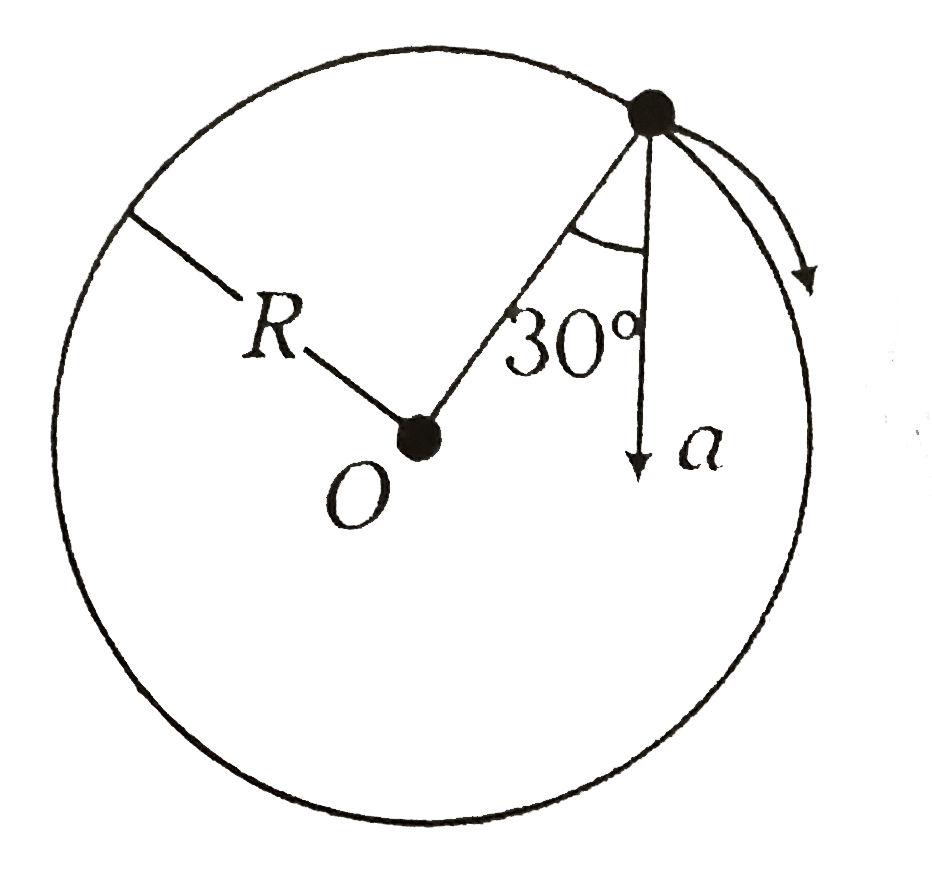Complete Solutions to Medical entrances s gallery of chapter CIRCULAR MOTION of Class 11 book with complete answers and questions
| Class 11 | PHYSICS |
| Chapter | CIRCULAR MOTION |
| DC PANDEY NEET | Medical entrances s gallery |
| Number Of Questions | 19 |
| Academic Year | 2023-24 |
In the given figure, `a=15m//s^(2)` represents the total acceleration of a particle moving in the clockwise dirction in a circle of radius `R=2.5`m at a given instant of time. The speed of the particle is
 01:59View Solution
01:59View SolutionA car is negotiating a curved road of radius R. The road is banked at angle `theta`. The coefficeint of friction between the tyres of the car and the road is `mu_(s)`. The maximum safe velocity on this road is
05:12View SolutionA uniform circular disc of radius 50 cm at rest is free to turn about an axis which is perpendicular to its plane and passes through its centre. It is subjected to a torque which produces a constant angular acceleration of 2 rad `s^(-1)`. Its net acceleration in `ms^(-2)` at the end of 2 s is approximately
02:44View SolutionWhat is the minimum velocity with which a body of mass m must enter a vertical loop of radius R so that it can complete the loop?
03:06View SolutionA particle of mass 10 g moves along a circle of radius `6.4` cm with a constant tangential acceleration. What is the magnitude of this acceleration. What is the magnitude of this acceleration, if the kinetic energy of the particle becomes equal to `8xx10^(-4)`J by the end of the second revolution after the beginning of the motion?
02:22View SolutionA fighter plane is pulling out for a dive at a speed of `900 km//h`. Assuming its path to be a vertical circle of radius `2000 m` and its mass to be `16000 kg`, find the force exerted by the air on it at the lowest point. Take `g=9.8 m//s^(2)`
02:20View SolutionA particle is moving in a curved path. Which of the following quantities may remain constant during its motion?
05:37View SolutionThe ratio of angular speed of a second-had to the hour-hand of a watch is
03:25View SolutionIf the length of second's hand of a clock is 10 cm, the speed of its dip (in `cm s^(-1)`) is nearly
02:22View SolutionA particle is moving uniformly in a circular path of radius r. When it moves through an angular displacement `theta`, then the magnitude of the corresponding linear displacement will be
03:50View SolutionA rotating wheel changes angular speed from 1800 rpm to 3000 rpm in 20 s. What is the angular acceleration assuming to be uniform?
01:21View SolutionThe expression from centripetal force depends upon mass of body, speed of the body and the radius of circular path. Find the expression for centripetal force.
01:35View SolutionUniform circular motion is an example of
03:15View SolutionA stone tied to a rope is rotated in a vertical circle with uniform speed. If the difference between the maximum and minimum tensions in the rope is 20 N, mass of the stone in kg is (take, g= 10 `ms^(-2)`)
View SolutionA particle moving in uniform circle makes 18 revolutions in 1 minutes. If the radius of the circle is 10 cm, the speed of the particle is
01:59View SolutionA car of mass `1000kg` negotiates a banked curve of radius `90m` on a fictionless road. If the banking angle is `45^(@)` the speed of the car is:
04:06View SolutionOn a railway curve, the outside rail is laid higher than the inside one so that resultant force exerted on the wheels of the rail car by the tops of the rails will
01:50View SolutionOne end of a string of length 1 m is tied to a body of mass `0.5` kg. It is whirled in a vertical circle with angular velocity 4 rad `s^(-1)`. Find the tension in the string when the body is at the lower most point of its motion. (take, g = 10 `ms^(-1)`)
01:34View SolutionA cane filled with water is revolved in a vertical circle of radius 4 m and water just does not fall down. The time period of revolution will be –
04:07View Solution
Medical entrances s gallery questions and complete solutions for chapter CIRCULAR MOTION of DC PANDEY PHYSICS (HINGLISH) of Class 11
All Exercises from DC PANDEY NEET Class 11 PHYSICS CIRCULAR MOTION
- Assertion And Reason
- Check point
- Comprehension
- Example
- Exercise 10.1
- Exercise 10.2
- Exercise 10.3
- Integer
- JEE Advanced
- JEE Main
- Level 1 Objective
- Level 1 Subjective
- Level 2 Comprehension Based
- Level 2 More Than One Correct
- Level 2 Single Correct
- Level 2 Subjective
- Match the columns
- Matrix Matching
- Medical entrances s gallery
- Miscellaneous Examples
- More than One Option is Correct
- Solved Examples
- Subjective Questions
- Taking it together
